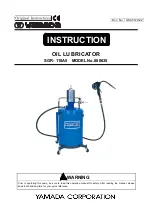
Seite 27 von 126
5. Decommissioning
-
The swimming pool is to be rendered winterproof according to the manufacturer's relevant
guidelines.
-
In case of any possible risk of frost, the filtration system must be rendered winterproof. The
following point must be observed in this case: the water is to be drained from the filter
cartridge
(4)
using the bleeder screw
(5)
located at the bottom of the filter cartridge
(4)
.
-
The lines from and to the swimming pool are to be completely drained.
-
Switch off the current (set to 0) and pull out the shock-proof plug.
-
Empty the silica sand out of the filter cartridge
(4)
and store the entire filtration system in a
frost-free area (e.g. in the cellar). Do not push or transport the filled cartridge; otherwise there
is a risk of breakage.
6. Causes of malfunctions – troubleshooting
6.1 Pump does not draw water on its own or suction time is too long
9.
Check whether the pre-filter is filled with water, at least up to the level of the suction
connection.
10.
Check the suction line for leaks, as air will be aspirated if leaks are present.
11.
Check the water level of the pool. The pump will likewise draw in air
if the water level in the skimmer is too low. Top up the water level to the middle of the
skimmer opening.
12.
Check that the skimmer flap is easily movable and does not jam. Otherwise the pump
will also fail to draw properly or the pressure head will be constantly interrupted.
This may result in pump damage.
13.
Check that the strainer baskets in the skimmer and those of the pre-filter of the pump
are not dirty and clean the strainer baskets if necessary.
14.
Check that the pre-filter cover of the pump rests flat and screwed tight.
15.
If the suction line is very long and is laid above the water level, a
non-spring-loaded check valve must be installed.
16.
Check that the gates in the suction and pressure line are open.
6.2 Motor circuit breaker trips
4. If the motor circuit breaker trips, only one attempt should be made to restart the pump,
i.e. by pushing the motor circuit breaker back in. On the second attempt,
inform an electrician and have the system checked (motor, supply leads, etc.).
5. Before operating the motor circuit breaker, rotate the pump impeller using a screwdriver
in
order
to
establish
that
the
pump
can
be
freely
rotated.
Caution: Only do this with the mains plug disconnected! Risk of injury!
6. If the pump is difficult to rotate, the impeller may be clogged. This is possible
if the pump has been running without a strainer. Unscrew the housing and clean the impeller
and housing.
6.3 Circulating pump delivers insufficient output
6. Filter is dirty and must be backwashed.
7. Gates in the system are not fully opened.
8. Strainer in the pump pre-filter and skimmer basket in the skimmer are dirty - cleaning required.
9. Hose line is too long and/or the suction head is too high.
10. Suction line is not airtight and the pump is drawing in air.
6.4 Circulating pump is noisy
5. Filter is dirty and must be backwashed.
6. Foreign bodies in the pump; unscrew the pump housing, clean the housing and impeller.
7. Motor bearings are noisy; replace the motor complete with the impeller.
8. The pump is placed on the bare wooden or concrete base; consequently, transmission of the
noise to the building (structure-borne noise) is possible and the pump is to be positioned on a
sound-proofing, insulating base (rubber, cork, etc.).
















































